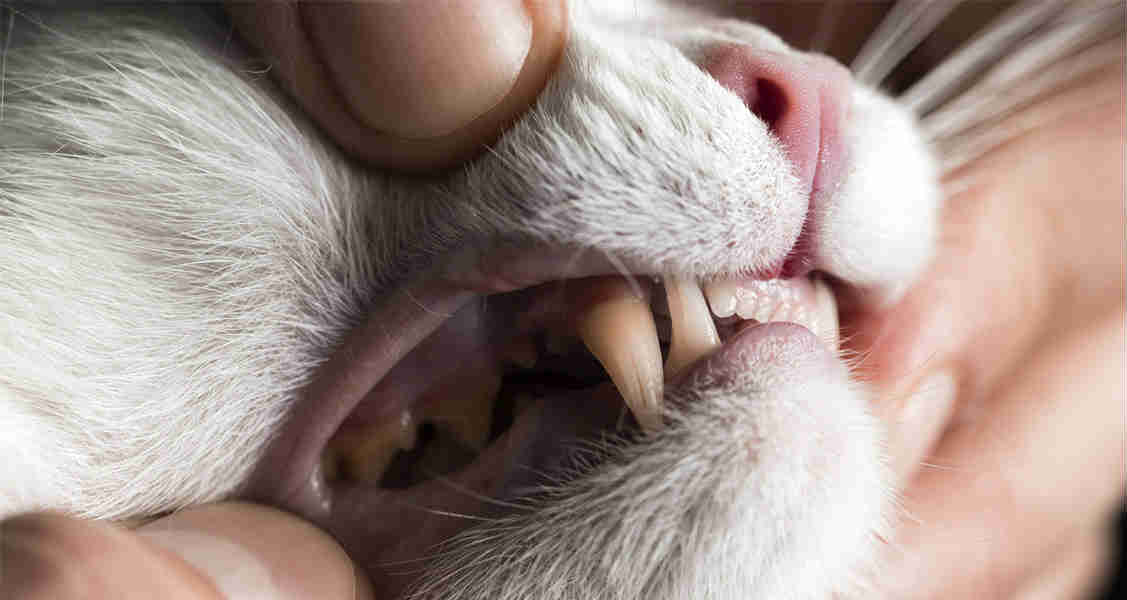How to Prevent Dental Disease in Cats and Dogs
By: Dr. Clayton Greenway, B.Sc., DVM | Jul 13, 2016

Dental disease is a common problem. It’s estimated that 85% of our pets have a significant degree of dental disease. Not many pet owners focus on this aspect of their pet’s health because it is largely unseen…we don’t often look in our pet’s mouth, particularly way at the back where dental disease in cats and dogs is more common. I’ve seen it advance to the point where it can have a severely negative impact on a pet’s quality of life and daily comfort. The mouth can end up being a source of infection that can spread to other sites in the body.
Small breed dogs and “brachycephalic breeds” (the breeds with the ultra-short muzzles like pugs, bulldogs, and Pekingese) are particularly prone to poor dental health. Their mouths are small and their teeth don’t oppose each other well. This causes tartar to accumulate easily. That tartar can then cause the gingiva or ‘gum’ to become inflamed, also known as gingivitis. This leads to periodontal disease, tooth root abscesses, pain and the loss of teeth. The same process will happen to any pet without sufficient dental care.
You can imagine how bad our teeth would be if we never brushed daily or refused to visit the dentist regularly. Our pets’ teeth are like ours: if they’re not taken care of, they’ll end up falling out just like ours would. With dental disease, an ounce of prevention is worth a pound of cure. There are a few things you can do to prevent tartar formation in your pet’s mouth. The two most effective things are brushing the teeth and a tartar diet.
Brushing is by far the best thing you can do. It sounds like a lot of work, but it is easily performed. Ask your veterinarian or the registered veterinary technicians at your local clinic to demonstrate brushing to you and give you tips on helping your pet gradually accept having their teeth brushed. It is important to only use an effective, enzymatic toothpaste when brushing. Products that carry the VOHC (Veterinary Oral Health Council) seal have been put through rigorous testing to confirm that they are effective. These kinds of VOHC approved toothpaste have enzymes that coat the teeth and prevent tartar accumulation and have antibacterial activity.
I don’t often recommend the other common items such as treats, chews, and solutions you add to the water. They may be supportive in the control of tartar and reducing bacteria in the mouth, but they are far less valuable than simple brushing and using dental diets. I am often amazed at our general thought that giving a pet a particular treat will clean canine and feline teeth—it’s a concept that seems to be well accepted amongst many pet owners. But I ask you, what treat do you eat to clean your teeth? If such a thing existed, we would be giving them to our kids and eating them ourselves on the way to work.
There are medical diets that are designed to scrape plaque off the teeth. Other medical diets contain products that mix with saliva to create an antibacterial effect in the mouth. I have worked as a veterinarian long enough to witness the effect that dental care dog food and cat food diets have and it is a profound impact. I would strongly caution pet owners to carefully evaluate these products— the packaging can make any claim without having to back it up. It’s important to speak to your veterinarian about these diets and confirm that it is one that is proven to work. Keep in mind that while a medical diet may be a little more expensive, it often is cheaper in the long run because it can help avoid expensive dental cleanings. I would also make a note here that I have seen some raw-food diets and non-traditional or homemade diets work well at preventing tartar, but again, you would want to evaluate these choices for yourself.
While prevention is important, dental cleaning under a general anaesthetic is the only way to truly remove tartar from the teeth and improve your pet’s oral health. I’ve known the occasional client that has bought a dental tool and scraped their pet’s teeth if they’re good enough to hold still, and in some cases, they can do a good job, but keep in mind that disease occurs under the gums as well. Accessing these areas requires anaesthesia. The previously mentioned strategies only reduce the progression of tartar development. Scaling and polishing the teeth under a general anaesthetic will remove all tartar and allow for a full evaluation of the integrity of the teeth. Visiting your veterinarian for an oral examination annually is key to monitoring the state of your pet’s mouth and keeping it healthy.


Disclaimer: healthcareforpets.com and its team of veterinarians and clinicians do not endorse any products, services, or recommended advice. All advice presented by our veterinarians, clinicians, tools, resources, etc is not meant to replace a regular physical exam and consultation with your primary veterinarian or other clinicians. We always encourage you to seek medical advice from your regular veterinarian.

